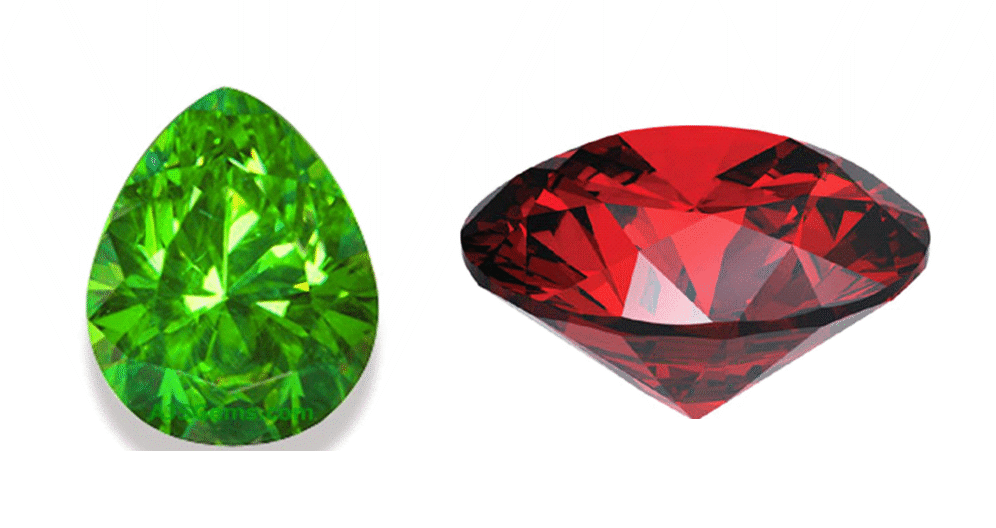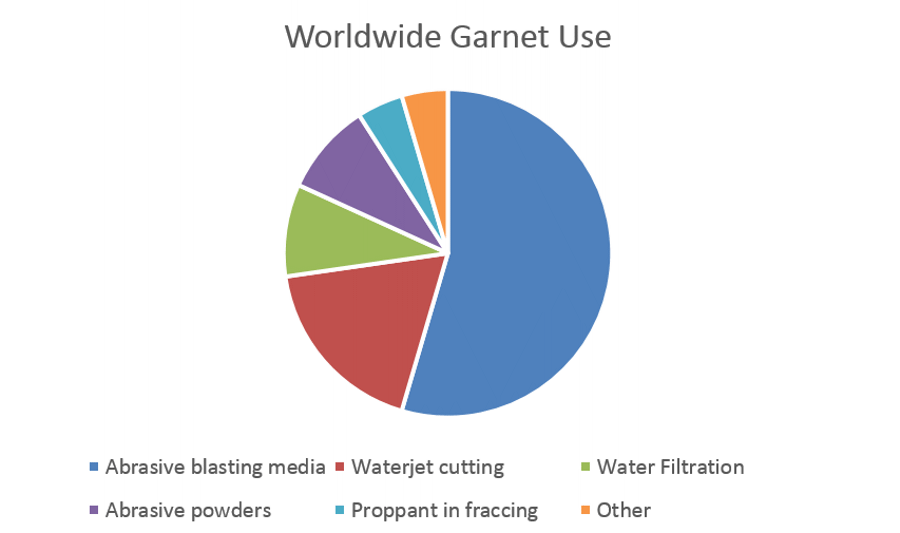Specialty Metals and Minerals: Garnet
Properties
All garnet minerals are alumino-silicates, the following table lists the most common types of garnet minerals. Note that these are “end member” formulas, it is possible for replacement to occur. For example, the calcium in grossular is often replaced by iron.
|
Mineral |
Formula |
Specific Gravity |
Hardness (Mohs) |
|
Almandine |
Fe3Al2(SiO4)3 |
4.25 |
7.5 – 8 |
|
Pyrope |
Mg3Al2(SiO4)3 |
3.56 |
7 – 7.5 |
|
Spessartine |
Mn3Al2(SiO4)3 |
4.18 |
6.5 – 7.5 |
|
Andradite |
Ca3Fe2(SiO4)3 |
3.90 |
6.5 – 7 |
|
Grossular |
Ca3Al2(SiO4)3 |
3.57 |
6.5 – 7.5 |
|
Uvarovite |
Ca3Cr2(SiO4)3 |
3.85 |
6.5 – 7 |
The key industrial properties of garnet are density and hardness. Thus, almandine is the most superior variety. Garnet is chemically inert and does not form polluting products upon breakdown.
High quality garnets of all varieties can occur as gemstone quality; a couple of examples are shown below. While most commonly red, garnet gemstones can also be orange, yellow, green and pink.
Uses
The chart below shows global garnet use, which varies by country. For example, in the US, unlike global consumption, abrasive blasting and water jet cutting consume comparable quantities of garnet.
Most Data from 2013 United States Geological Survey (“USGS”)
Abrasive blasting (sand blasting) uses larger grains, generally greater than 60 mesh (250 micrometres). Water jet cutting uses smaller grains, from 60 mesh to 200 mesh. Angular grains perform better than rounded grains.
Several natural and synthetic materials can substitute for garnet, but many are inferior to garnet. Natural substitutes include staurolite (an iron alumino-silicate), quartz and corundum. Synthetic substitutes include aluminium oxide and silicon carbide.
Garnet is rapidly replacing silica (quartz) in sand blasting because of silica’s adverse effect on health. Numerous countries already ban the use of silica, and others are expected to follow.
Production & Resources
According to the USGS, world production in 2015 amounted to 1.66M tonnes. India was the leading producer (0.8Mt), followed by China (0.52Mt), Australia (0.26Mt), the US (0.03Mt) and others (0.05Mt). Small operations have been reported in other countries such as Russia, Chile and Pakistan.
World reserves and resources of garnet are huge, but high quality almandine garnet is much less common. The deposits are either hard rock (hosted by schists and gneisses), or alluvial (heavy mineral sand deposits and gravel).
The largest reserves are in China, India, Australia and the US. However, there are resources in many other countries. For example, the Barrytown deposit in New Zealand. It is high quality almandine with a total exploration target of 25 to 35 M tonnes of garnet.
The Market
The garnet market is quite opaque. Prices are set between buyers and sellers and usually kept confidential. However, there is some information that gives an indicative, average price range.
According to the USGS, in 2015 the US imported garnet at an average price of USD213/t. Crude garnet concentrates fetched USD75 to USD210/t and refined garnet USD200 to USD335/t.
Persistence Market Research estimates that the global garnet market had revenue of USD475M in 2016 and USD454M in 2015. Given that global production was 1.66mt in 2015, that infers an average price of USD273/t.
There are some outliers. For example, Freeport Resources Inc. has a beach sand garnet deposit in northern Labrador. It seems a good quality deposit but does face some difficulties; it is near the Arctic Circle, and located in a National Park. The company estimates that their water jet quality garnet would sell for USD375 to USD935/t.
In conclusion, it would seem reasonable to assume an average garnet price for a deposit of good quality almandine would be north of USD300/t.
The total market is expected to grow at a CAGR of around 5% for the foreseeable future. Some of the factors that could positively affect prices and market growth include:
- Continuing strong uptake of water jet cutting, the US is by far the most mature market, but US growth is still strong, thought to be above 10%pa. The rest of the world is at a very early stage in the uptake of this technology. World growth will be strong.
- Increasing regulation, or banning, of competitive products such as silica sand and slag, for health reasons.
- Increasing recycling. Much garnet is able to be re-used up to 5 times after recycling. This reduces the overall cost and demand increases, such that garnet replaces cheaper products that cannot be recycled. Think of the way aluminium cans replaced steel back in the day. They were more expensive but cheaply recycled. Demand skyrocketed.
- Garnet continues to replace alternative products for speed, as well as cleanliness and cost effectiveness. Using garnet rather that alternative products for water blasting can reduce blasting time by as much as 50%. The increased cost is far outweighed by the improved productivity.
Conclusion
The garnet business is growing strongly, particularly for the best grade products, used in water jet cutting. However, investment in the business is difficult. To my knowledge there is no listed garnet producer, at least on Western exchanges, so the typical investor will not get a look in. However, there is one possible future listed opportunity that could be worth a look. The Australian owner of the Barrytown Project, in New Zealand, will possibly list the project within the next year or so. Read more here.


